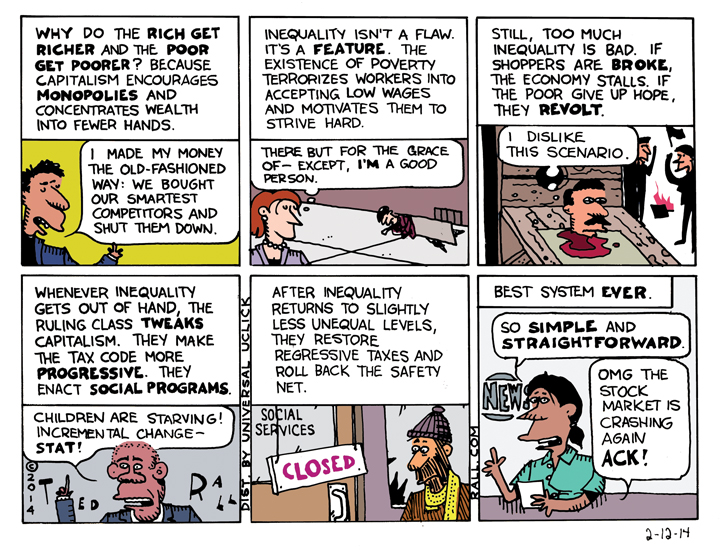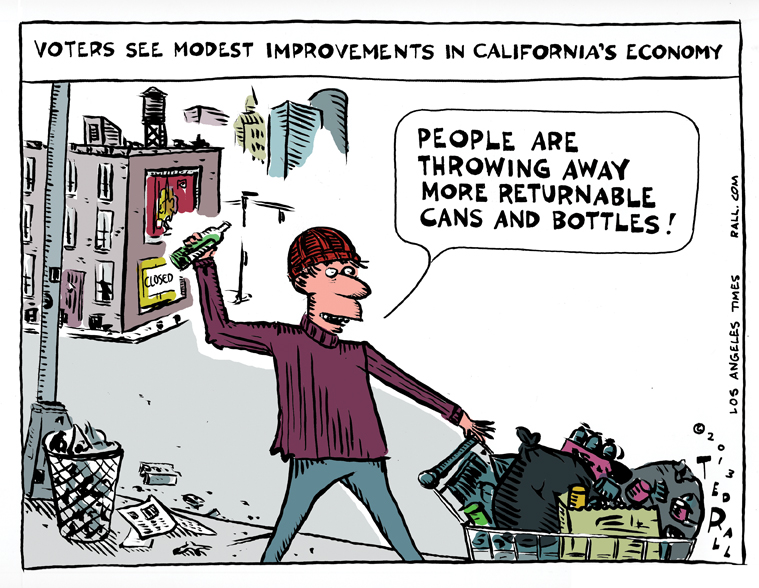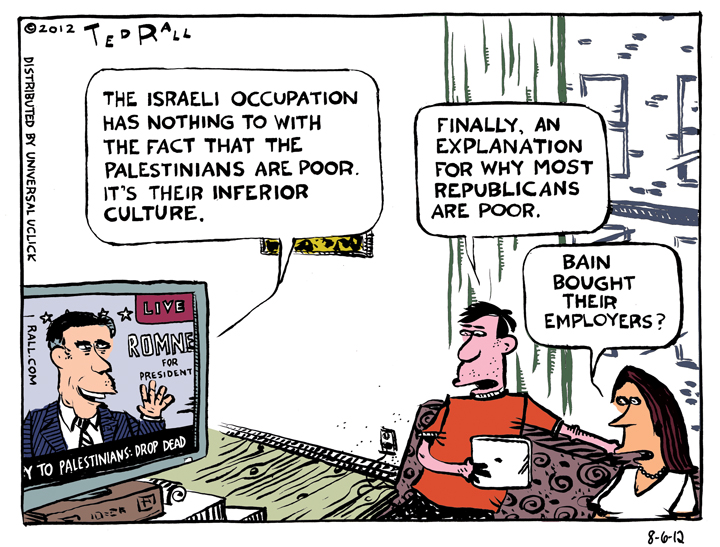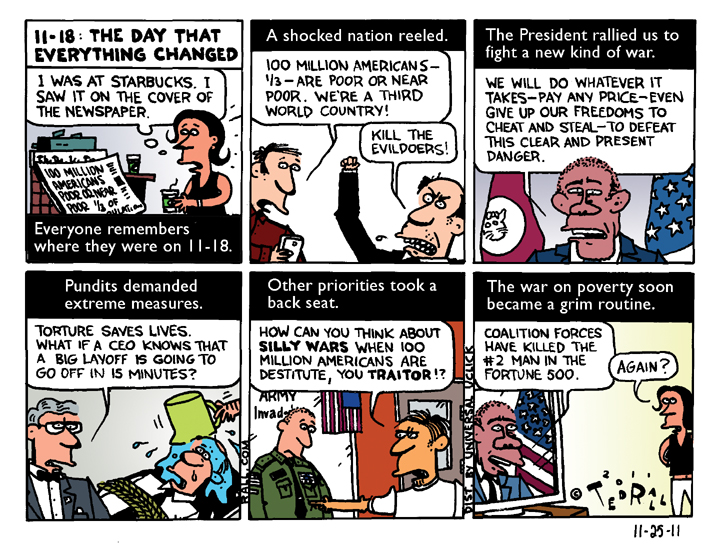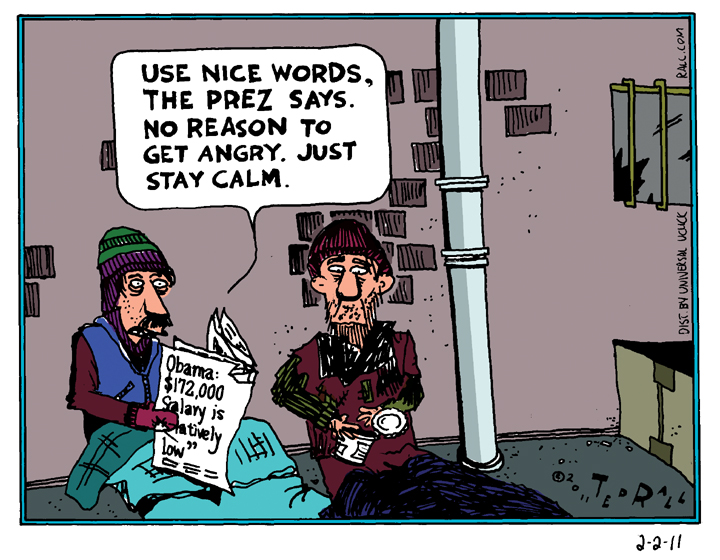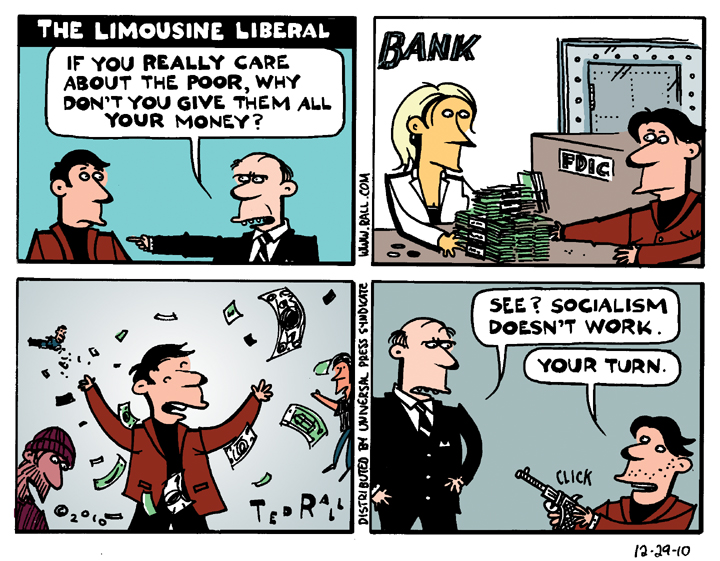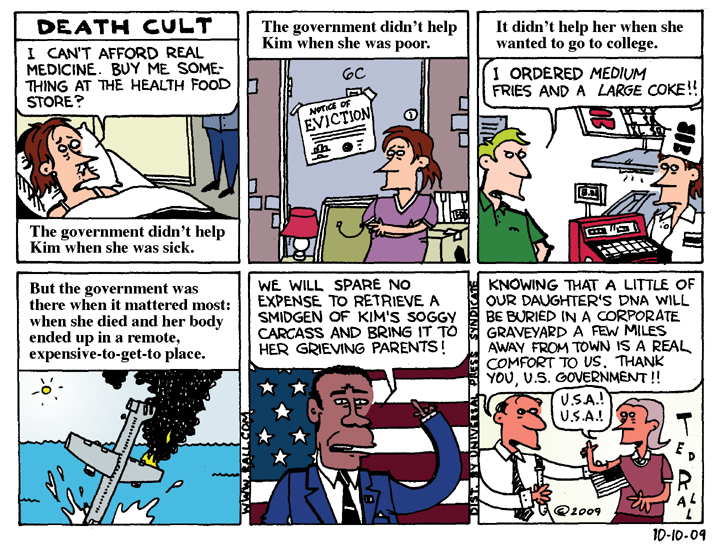President Obama and the Democrats have finally decided, five years after his election, to begin talking about the issue of income inequality, which has been increasing since the early 1970s. But their rhetoric makes it sound like inequality is a weird byproduct of capitalism when, in fact, it is a key feature of an economic system that relies on poverty and exploitation. This is the best system ever conceived?
LOS ANGELES TIMES CARTOON: Modest Improvement
I draw cartoons for The Los Angeles Times about issues related to California and the Southland (metro Los Angeles).
This week: Voters see modest improvements in California’s economy.
SYNDICATED COLUMN: Our Politicians Need an Education
Why Both Democrats and Republicans Miss the Big Picture
Public education is mirroring American society overall: a tiny island of haves surrounded by a vast ocean of have-nots.
For worried parents and students, the good news is that spending on public education has become a campaign issue. Mitt Romney is pushing a warmed-over version of the old GOP school voucher scheme, “school choice.” The trouble with vouchers, experts say (and common sense supports), is that allowing parents to vote with their feet by withdrawing their kids from “failing schools” deprives cash-starved schools of more funds, leading to a death cycle—a “winner takes all” sweepstakes that widens the gap between the best and worst schools. Critics—liberals and libertarians—also dislike vouchers because they allow the transfer of public tax dollars into the coffers of private schools, many of which have religious, non-secular curricula unaccountable to regulators.
Romney recently attacked President Obama: “He says we need more firemen, more policemen, more teachers. Did he not get the message of [the failed recall of the union-busting governor of] Wisconsin?”
“I would suggest [Romney is] living on a different planet if he thinks that’s a prescription for a better planet,” shot back Obama strategist David Axelrod.
Both parties are missing the mark, the Republicans more than the Democrats. Republicans want to gut public schools by slashing budgets that will lead to bigger class sizes, which will reduce the individual attention dedicated to teaching each student. Democrats rightly oppose educational austerity, but are running a lame defense rather than aggressively promoting positive ideas to improve the system. Both parties are too interested in weakening unions and grading teacher performance with endless tests, and not enough in raising salaries so teaching attracts the brightest college graduates. Not even the Democrats are calling for big spending increases on education.
Is the system really in crisis? Yes, said respondents to a 2011 Gallup-Phi Delta Kappa poll, which found that only 22 percent approved of the state of public education in the U.S. The number one problem? Not enough funding, say voters.
Millions of parents whose opinion of their local public system is so dim that they spend tens of thousands of dollars a year on private school tuition and—in competitive cities like New York City, force their kids to endure a grueling application process.
According to one of the world’s leading experts on comparing public school systems, Andreas Schleicher of the Organization for Economic Cooperation and Development, the U.S. is falling rapidly behind other countries. In Canada, he told a 2010 Congressional inquiry, an average 15-year-old ahead is a full year ahead his or her American counterpart. The U.S. high-school completion rate is ranked 25th out of the 30 OECD countries.
The elephant in the room, the idea neither party is willing to consider, is to replace localized control of education—funding, administration and curricula—with centralized federal control, as is common in Europe and around the world.
“America’s system of standards, curriculums and testing controlled by states and local districts with a heavy overlay of federal rules is a ‘quite unique’ mix of decentralization and central control,” The New York Times paraphrased Schleicher’s testimony. “More successful nations, he said, maintain central control over standards and curriculum, but give local schools more freedom from regulation, he said.”
Why run public schools out of Washington? The advantages are obvious. When schools in rich districts get the same resource allocation per student as those in poor ones, influential voters among the upper and middle classes tend to push for increased spending of education. Centralized control also eliminates embarrassing situations like when the Kansas School Board eliminated teaching evolution in its schools, effectively reducing standards.
A streamlined curriculum creates smarter students. It’s easier for Americans, who live in a highly mobile society, to transfer their children midyear from school to school, when a school in Peoria teaches the same math lesson the same week as one in Honolulu. Many students, especially among the working poor, suffer lower grades due to transiency.
Of course, true education reform would need to abolish the ability of wealthier parents to opt out of the public school system. That means banning private education and the “separate but equal” class segregation we see today, particularly in big cities, and integrating the 5.3 million kids (just under 10 percent of the total) in private primary and secondary schools into their local public systems. Decades after forced bussing, many students attend schools as racially separated as those of the Jim Crow era. The New York Times found that 650 out of New York’s 1700 public schools have student bodies composed at least 70 percent of one race—this in a city with extremely diverse demographics.
If we’re to live in a true democracy, all of our kids have to attend the same schools.
(Ted Rall’s new book is “The Book of Obama: How We Went From Hope and Change to the Age of Revolt.” His website is tedrall.com. This column originally appeared at MSNBC.com)
(C) 2012 TED RALL, ALL RIGHTS RESERVED.
SYNDICATED COLUMN: 7-7-7
Jobless? Face It: Obama’s Not That Into You
Forget Herman Cain’s 9-9-9. The battle cry for every American ought to be 7-7-7.
7-7-7: for the $7.7 trillion the Bush and Obama Administrations secretly funneled to the banksters.
Remember the $700 billion bailout that prompted rage from right to left? Which inspired millions to join the Tea Party and the Occupy movements? Turns out that that was a mere drop in the bucket, less than a tenth of what the Federal Reserve Bank doled out to the big banks.
Bloomberg Markets Magazine reports a shocking story that emerged from tens of thousands of documents released under the Freedom of Information Act: by March 2009, the Fed shelled out $7.77 trillion “to rescuing the financial system, more than half the value of everything produced in the U.S. that year.”
The U.S. national debt is currently a record $14 trillion.
We knew that the Fed and the White House were pawns of Wall Street. What’s new is the scale of the conspiracy.
Even the most jaded financial reporters were stunned at the extent of collusion: “The Fed didn’t tell anyone which banks were in trouble so deep they required a combined $1.2 trillion on Dec. 5, 2008, their single neediest day. Bankers didn’t mention that they took tens of billions of dollars in emergency loans at the same time they were assuring investors their firms were healthy. And no one calculated until now that banks reaped an estimated $13 billion of income by taking advantage of the Fed’s below-market rates.”
Citigroup earned an extra $1.8 billion by reinvesting the Fed’s below-market loans. Bank of America made $1.5 billion.
Bear in mind, that’s only through March 2009.
“Many Americans are struggling to understand why banks deserve such preferential treatment while millions of homeowners are being denied assistance and are at increasing risk of foreclosure,” wrote Representative Elijah Cummings, a ranking member of the House Committee on Oversight and Government Reform who is demanding an investigation.
Indeed we are.
This stinks. It’s terrible economics. And it’s unbelievably cruel.
First the economics. The bank bailouts were supposed to loosen credit in order to encourage lending, investment, job creation and ultimately consumer spending. It didn’t work. Banks and corporations alike are hoarding cash. President Obama, who promised 4 million net new jobs by earlier this year, has been reduced to claiming that unemployment would have been even higher without the bailouts.
Ask any business executive why nobody is hiring and they’ll blame the lack of consumer demand. If the ultimate goal is to put more money into people’s pockets, why not just, you know, put more money into people’s pockets?
Bank executives used federal taxdollars to pay themselves tens of billions in bonuses and renovate their corporate headquarters. We the people got 0-0-0. What if we’d gotten 7-7-7 instead?
Every man, woman in child in the United States would have received $24,000.
A family of four would have gotten $96,000.
And that’s without an income test.
New data from the U.S. Census Bureau shows that 100 million American citizens—one of out of three—subsists below or just above the official poverty line. Demographers, statisticians and economists were stunned. “These numbers are higher than we anticipated,” Trudi J. Renwick, the bureau’s chief poverty statistician, told The New York Times. “There are more people struggling than the official numbers show.”
For four decades progressive economists have warned that the middle-class was being eroded, that the United States would become a Third World country if income inequality continued to expand. They can stop. We’re there.
These poor and “near poor” Americans comprise the vast majority of the uninsured, un- and underemployed, and foreclosure victims. If Bush-Obama’s 7-7-7 Plan had gone to each one of these 100 million misérables instead of Citigroup and Bank of America, the IRS would have mailed out 100 million checks for $77,700 each.
This would have paid off a lot of credit cards. Kept millions in their homes, protecting neighborhood property values. Allowed millions to see a doctor. Paid for food.
A lot of the money would have been “wasted” on new cars, Xboxes—maybe even a renovation or two. All of which would have created a buttload of consumer demand.
If you’re a “99er”—one of millions who have run out of unemployment benefits—Obama’s plan for you is 0-0-0.
If you’re one of the roughly 20 million homeowners who have lost or are about to lose your house to foreclosure—most likely to a bank using fraudulent loan documents—you get 0-0-0.
If you’re a teacher asking for a raise, or a parent caring for a sick child or parent, or just an ordinary worker hobbling to work on an old car that needs to be replaced, all you’ll get is 0-0-0.
There isn’t any money to help you.
We don’t have the budget.
We’re broke.
You can’t get the bank to call you back about refinancing, much less the attention of your Congressman.
But not if you’re a banker.
Bankers get their calls returned. They get anything they want.
There’s always a budget for them.
They get 7-7-7.
(Ted Rall is the author of “The Anti-American Manifesto.” His website is tedrall.com.)
COPYRIGHT 2011 TED RALL
Death Cult
It’s hard to say exactly what inspired this cartoon. It’s nothing in recent news, but rather my long-term observation that the U.S. government goes to extreme lengths to retrieve body parts. Examples include the 9/11 recovery effort and the decades-long campaign to get back body parts from U.S. servicemen who perished in Vietnam during the 1960s. Wouldn’t it make more sense to care about Americans while they’re alive?

